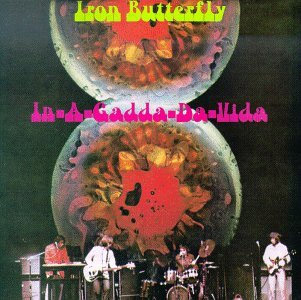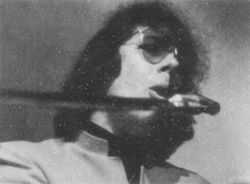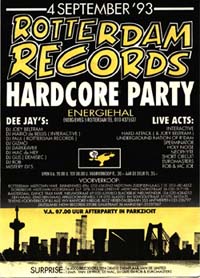
From the official band biography:
In July of 1968, Iron Butterfly released the monumental LP, In-A-Gadda-Da-Vida, featuring the 17:05 minute side-long track that shook the entire music industry with its phenomenal reception. ‘Vida outsold every record in the history of recorded music within the first year of its release (over eight million copies sold) and therefore outgrew and outsold the standard of the music industry’s “Gold Album” award. For this achievment, Iron Butterfly was subsequently awarded: The Industry’s Very First “Platinum Album”! This historic award was created and presented by then-president of ATCO Records Ahmet Ertegun, who went on to become the current CEO of the WEA Group.
There has been much speculation regarding the origins of the title of the track and after a bit of digging I have uncovered some details which may surprise even the band’s most ardent admirers. First of all, a little background is needed:

In the summer of 1959 avant garde artist Brion Gysin invented the cut up method whilst staying in the notorious Beat Hotel, 9 Rue Git-le-Coeur, on Paris’ left bank. This technique, by which texts were cut with scissors and then reassembled in a new order, was later popularised by author William Burroughs. Burroughs found that many of the “new” texts he produced out of cut ups seemed to refer to events which later actually occurred in real life. He described this as letting “the future leak through”.

The title “In a Gadda da Vida” is usually credited to singer Doug Ingle being (it is alleged) mashed off his tits on drugs and mumbling “In the Garden of Eden”.

However another version of the story is that the title is in fact down to drummer Ron Busby. Ron was one of the less notorious visitors to Gysin and Burroughs at the Beat Hotel in the 60s. As with many drummers of the time (and since) he had delusions of creative talent which were beyond his scope.
On returning to San Diego, Ron began experimenting with Gysin’s various techniques, constructing a dream-machine in his downtown apartment, playing The Master Musicians of Jajouka LP released by Brian Jones at all hours of the day and going crazy with a “prepared” paint roller. His cut ups were spectacularly dull, even when compared to the rest of the genre.
It is rumoured that the phrase “In a Gadda Da Vida” was the result of him cutting up an interview in “Time Magazine” with hairdresser and veteran anti-fascist Vidal Sassoon. (Sassoon was a member of the militant anti-fascist “43 Group” comprised of jewish ex-servicemen who had fought for England in WW2 only to find Oswald Mosely’s fascists on the streets of the east end when they returned to London. The solution to this was simple: militant physical confrontations at their street rallies. As Sassoon later put it “We beat them because we hated, and were more ruthless.”)
Busby is rumoured to have laughed for days about the hilarity of “cutting up” an interview with someone discussing cutting hair. The rest of the group took pity on him and used the title for what is probably their most famous track. The tune was later covered by everyone from the Incredible Bongo Band to thrash metallers Slayer, and played a key role in the film Manhunter (the precursor to Silence of the Lambs).

In a strange quirk of fate, the title did actually “let the future leak through” in the early 90s when Holland fell under the thrall of the dance music revolution.
In Rotterdam especially, the sounds of techno artists like The Mover and Second Phase were hugely popular and it wasn’t long before the city spawned a bewildering array of producers (3 Steps Ahead, Drokz, Annihilation, Rotterdam Termination Source, etc) of home grown ‘ardkore.

As with all scenes, exclusivity and tribalism were the order of the day in its formative stages. A line was drawn between those involved – and everyone else. Huge amounts of venom were directed at rival city Amsterdam and producers such as Paul Elstak who were perceived as selling out. The scene developed its own style, fashion and language alongside the music.
Ravers in Holland were typical working class kids, well used to blagging, brushes with the law, and bouncers excluding them from nightclubs. The term “gabber” or “gabba” is said to be derived from the Yiddish word khaver, meaning “friend” (or rather “mate”/”blud” etc) which was used by kids in the Netherlands. Apocryphally, the term sparked an entire genre when one kid wanted to enter a club in Amsterdam, where the bouncer said, “No gabber, you can’t come in here.”
In exactly the same situation in the UK, a member of the Kemet Crew was refused entry to a club which was actually playing one of his own techno productions at the time for looking too “ragga”. In both countries, the excluded were inspired to create their own music and clubs, consisting of a “roughness” diametrically opposed to the “smoothness” of mainstream clubbing.
“Inna Gabba Da Vida” became a key phrase in the early days of Rotterdam hardcore, mashing together Jamaican patois, yiddish and spanish. It displays a positive mongrel attitude completely natural to urban working class youth – used to living and working cheek by jowl with people from all over the world (something which isn’t always the case for middle class liberals, it has to be said).
Basically translating as “Hardcore For Life”, the phrase appeared on club flyers and record labels as a badge of credibility – a badge that could never be worn by “weekenders” or by “smooth” clubbers.
thank you!
Fabulous post, John.
excellent post… always worried about why i loved that song (kinda figured it was because of Michael Mann’s Manhunter) – and now it’s becoming clear… you just know like you do a good melon…
Hilarious! How long have you been cooking this one up for? Great to see this little-known corner of musical history revealed…
faaaantastic. wheeeee!
this is on at the mo btw
http://www.riflemaker.org/s-Part%20one%20-%20Dead%20Aim
wild connections, john. nice one!
Thanks for comments 🙂
When I found out about all this, I just felt the world should know! 😉
MMS, yeah a mate was trying to get me to that exhibition but their opening hours are a bit restrictive for me. Boo.
“In the Garden of Eden” …wicked.
When I 1st heard In A Gadda Da Vida On Vinyl It Blew My Mind away & I was Shocked that it took up a Whole side 2 of a Record Alot Ppl Say that I was Born in the wrong era & maybe there right I was. lol I alway’s wonder what these Bands & Singers Are doing today After they Made there Biggest One Hit Wonders Where Ever u Are Iron Butterfly U Rock Ur Music Fan Bruce……
Blimey, wonder how the Gabber-Yiddish link wouldn’t go down too well with the new generation of gabbers, a lot of whom are white-laced, DM-ed, bomberjacketed, wannabe Nazi boys and girls. Check the hollandhardcore site out for pictures of the new generation.
oh I liked the bit about Vidal Sassoon best – nice!
Why all the hoopla about the meaning of the title. What is the meaning of the SONG? Or is it just a given that it is the story of the Garden of Eden?
Pingback: UNCARVED.ORG BLOG » BLOG ARCHIVE » SEARCHIN’ – LOOKIN’ FOR LOVE
His name’s Ron BUSHY….
The truth (according to the liner notes on ‘the best of’ CD compilation) is that drummer Ron Bushy was listening to the track through headphones, and he just couldn’t hear correctly; he simply distorted what Doug Ingle answered when Ron asked him for the title of the song.
http://en.wikipedia.org/wiki/Ron_Bushy